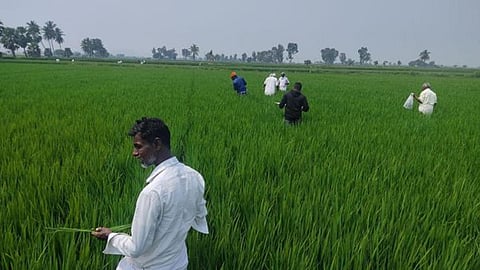
- Topics
- Feature
- Opportunities & Events
- Data
- Hindi Portal
- Topics
- Feature
- Opportunities & Events
- Data
- Hindi Portal

Our needs are numerous, with food, clothing, and shelter being our basic requirements. Ensuring basic food security is paramount for any country, as relying on others for our survival is quite risky. Fortunately, rice and wheat are the two prominent staple food crops that are widely and abundantly grown in India to feed the masses. Cotton, a fibre crop, is extensively used in the textile industry, along with other synthetic fibres. Sugarcane is also cultivated across the country, as sugar is a daily requirement in our diet.
India is a vast and diverse country with 15 Agroclimatic Zones, further divided into 72 sub-zones. Our varied geographic and climatic conditions enable us to grow a wide range of cereals, pulses, oilseeds, spices, fibre crops, fruits, nuts, vegetables, and other commercial crops. The arable land covers 165.67 million hectares, the highest in the world.
Although we take pride in achieving self-sufficiency in food, primarily due to advancements during the Green Revolution, the uncertainties of monsoons and the changing climate pose a threat to our ongoing success. To ensure resilience in agriculture, it is crucial to comprehend the gravity of the situation and implement corrective measures.
Crop water management is crucial in agriculture, especially in rice, wheat, sugarcane and cotton since they take away almost 90% of our irrigation water
and occupy 46% of the gross cropped area. There is tremendous
scope to improve water use efficiency (WUE) since it is only around 38% in India compared to around 60% in the developed countries.
The physical water productivity is also low in major crops in India compared to the developed world. A 5% increase in water productivity in rice would save around 11 BCM of water which is huge while the National Water Mission has set a 20% increase in water use efficiency as one of its goals.
The Ministry of Agriculture and Farmers’ Welfare, Government of India, has framed several policies and programmes for increasing crop productivity and water use efficiency to enhance farm income on a sustainable basis. The National Mission on Sustainable Agriculture (NMSA) for promoting organic farming, the Pradhan Mantri Krishi Sinchayee Yojana (PMKSY) for accelerating the adoption of microirrigation, and the PM PRANAM Scheme for reducing the use of chemical fertilisers are some of the efforts in that direction.
With such a robust network of institutions and programmes aimed at promoting high-quality agricultural practices, the result on the ground is not in the expected range.
The data from government agencies shows that the budget allocations for these key programmes are not fully utilised by the states, though we feel that the budget allocations are not adequate since these are very critical issues for farmers and the environment. For instance, the allocation for NMSA was Rs. 15,500 crore during 2022–23, while the utilisation was only Rs. 12,376 crore. The reduced utilisation had a bearing on the allocation for the year 2023–24, which was only Rs. 13,645 crore. Similarly, PMKSY allocation for the Jal Shakti Ministry was Rs. 10,954 crore, whereas the utilisation was only Rs. 7,084 crore, and the allocation was reduced to Rs. 8,587 crore for 2023–24.
The gaps in educating the farmers and convincing them of best practices with the assurance of better net income seem to be an issue.
Ensuring the timely availability of key inputs, equipment and devices needed for transitioning to a new way of agriculture is another issue that needs to be sorted out. While propagating any new technology there is a need to highlight the flipsides and mitigation measures, not only the bright side of it. There may be several other issues that farmers might focus on if we engage in an honest conversation with them.
The WUCS and FPOs are legal entities and exist in large numbers across the country.
Coordinated efforts by multiple agencies including civil society groups in reviving them through education and empowerment approaches will go a long way in improving farm productivity sustainably, managing the scarce resources judiciously and doubling the farmers’ income.
Developing a basket of options suitable for their crops and region and allowing them the flexibility to transition gradually towards an eco-friendly and sustainable crop production system might be useful.